Pupil No.189 at the Royal Freemasons’ School was Louisa Ashford Brooke Vavasour. The school register gives her birthdate, the names of her parents and her home address and from this it has been possible to research her life.

Born on November 6th in Topsham, Devon, she was baptised at St Margaret’s in Topsham on 12 June 1803, the fourth child of Nicholas Vavasour and his wife Dorothea.

Her parents had been married by licence on 14 February 1793 in Kingston, Devon, which refers to them as Mr Nicholas Vavasour of Ermington and Miss Dorothy Frowde of this parish and the use of a courtesy title implies families of good standing. Dorothea, interestingly, signs her name as ffrowde, the double ff originating as a variant script for capital F.
“When the modern capital F was introduced along with Italic writing in the Elizabethan era many of the “ff” families retained their double initial small f; presumably to retain continuity with records such as patents of nobility, land deeds, court rolls, and qualifications etc.”
http://old.qi.com/talk/viewtopic.php?t=9763&start=24&sid=1f67ed5f7f76c8056a985f118df92f11
The surname Vavasour belongs to an English Catholic family dating back to Norman times and amongst other Vavasour antecedents are included Thomas Vavasour (c. 1536–1585), physician and recusant of the reign of Queen Elizabeth I, Thomas Vavasour (1560-1620), Knight Marshal to King James I and the London publisher of Christopher Marlowe’s The Jew of Malta in 1630, Nicholas Vavasour.
On the female side was Anne Vavasour who was at the court of Elizabeth I c.1580. Whether one views her as an independently-minded lady or a woman of independent morals, the fact remains that she became mistress to two high-powered men and had sons by both. Her first lover was Edward de Vere, 17th Earl of Oxford and both she and the Earl were sent to the Tower of London by the Queen because of their illegitimate son. Anne later became the mistress of Sir Henry Lee of Ditchley by whom she had another illegitimate son. In 1590, she married a sea captain but then married again whilst the first husband was still alive. She was brought before the High Commission charged with bigamy and was fined the eye-watering sum of £2000 – the equivalent today of some quarter of a million pounds.
The poem Anne Vavasour’s Echo, most often identified as being written by de Vere, Earl of Oxford, is likely to have been inspired by Anne and may even have been written by her. However Steven May, in The poems of Edward de Vere, seventeenth Earl of Oxford and Robert Devereaux, second Earl of Essex (in Studies in Philology, 77, Winter 1980, Chapel Hill), is less inclined by this view and believes that the authorship may be neither of them.

Anne Vavasour (c. 1560–c. 1650), Maid of Honour to Queen Elizabeth I, and mistress of Edward de Vere, 17th Earl of Oxford; Attributed to John de Critz the Elder, https://commons.wikimedia.org/w/index.php?curid=6247362
Whether Louisa is descended from any of these persons would take much more detailed genealogy to uncover but she certainly shared their name.
It seems likely that Louisa’s father (born c. 1759) died in 1799 in Kingston, Devon. Subsequently, Louisa joined the School on 11 October 1810 when it was at St George’s Fields.
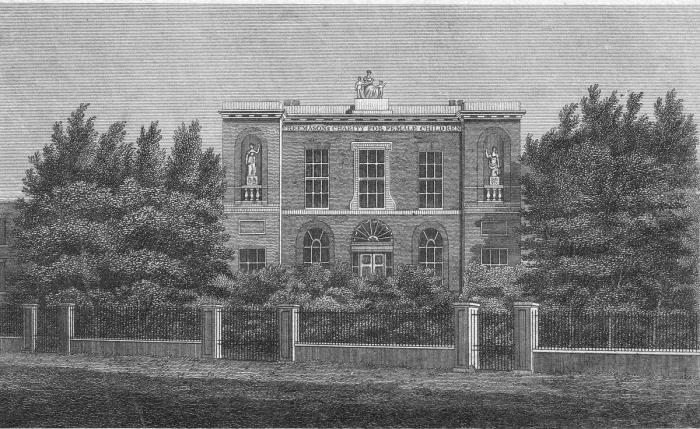
Her time at school having passed without note, she left in November 1817 and returned to her mother then living in Topsham. What she did there for the next few years is not known but in 1836, having spent some time on the continent to perfect her French, Louisa opened a school for young ladies which she ran with her sisters.

Operating from premises in Lemon Road, it became known as the Lemon Villa Establishment.
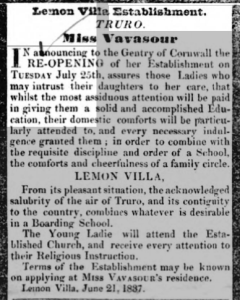
This indicates that not only was Louisa running a school from her residence but that this continued to be her home after her marriage.
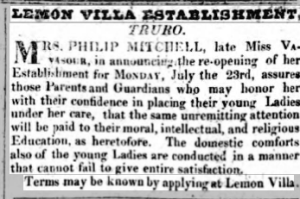
She clearly maintained her school after her marriage, somewhat unusual for the time. She had married Philip Mitchell on 25 June 1838 at Kenwyn church. Her announcement that the school would be re-opening – a standard indication that a new term was beginning; she uses similar wording in all of them – just a month after her wedding does seem to indicate ‘business as usual’.
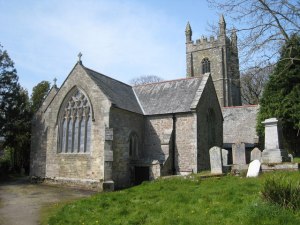
Another in 1840 clearly indicates that, not only was Louisa continuing the school that she and her sisters had been involved in, but she was also expanding its remit.
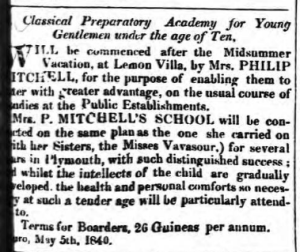
Sadly, the same church in which Louisa and Philip were married was to be the place of an unhappier occasion not long afterwards as the Royal Cornwall Gazette on 07 May 1841 carries the announcement of the death of Dorothea Vavasour, Louisa’s mother. Her death in Truro also acknowledged that their home had been Topsham. She is buried in Kenwyn churchyard. (Image of Topsham from http://www.topsham.org.uk/)
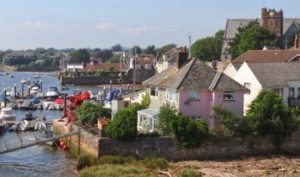
Although frequently ‘disguised’ by inaccurate census returns, it is clear that Philip was younger than his wife – he was born in 1814, making him some 11 years younger. Although census returns are notoriously inaccurate about ages, the discrepancy in ages was ‘diluted’ in every census return in which Louisa appears which might suggest that they were perhaps a shade embarrassed about it.
In 1841, the couple lived at Lemon Villa, Truro then in the equally delightfully named Summerland Terrace in 1851, although this was in Plymouth. It is believed that the family moved to Plymouth shortly after their third child was born. Ten years later and their address was Hill Park Villas, followed by Bedford Terrace. Of the Plymouth residences, only Bedford Terrace remains extant. Lemon Street in Truro still survives and at No 13 currently (Louisa’s school appears to have been at No. 46) is the Lemon Street art gallery, an interesting development given Philip’s occupation. The image below (from Google Earth) may be Lemon Villa although it is not certain. All that can be said is that it is in about the right place in lemon St, and of the right sort of age and size.

Philip earned his living as an artist and took frequent sketching tours through Cornwall and as far afield as Derbyshire.

The Angler’s rest – Miller’s Dale, Buxton, Derbyshire; Plymouth Breakwater Lighthouse looking Towards Mount Edgecumbe; The beach at Cawsand.
He exhibited first in 1846 at the Royal Cornwall Polytechnic Society Annual Exhibition where he won a Bronze Medal for a watercolour and a First Class prize for his chalk drawing. He became an Associate of the Royal Institute in 1854 and a Full Member in 1879 entitling him to add the initials RI after his name.
(Information from http://cornwallartists.org/cornwall-artists/philip-mitchell)
The 1871 census is the last public record in which Louisa appears. She died in 1873 aged 70 (finally the records noting the correct age!) but Philip continued to live in Plymouth (at 7 Alexandra Road) until his own death in 1896. Probate was granted to his daughter Juliet Vavasour Mitchell.
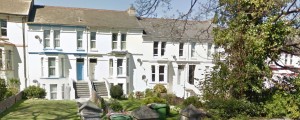
The little girl of seven years of age who left her home in Devon to attend a school in London for seven years lived for seven decades: an interesting symmetry.